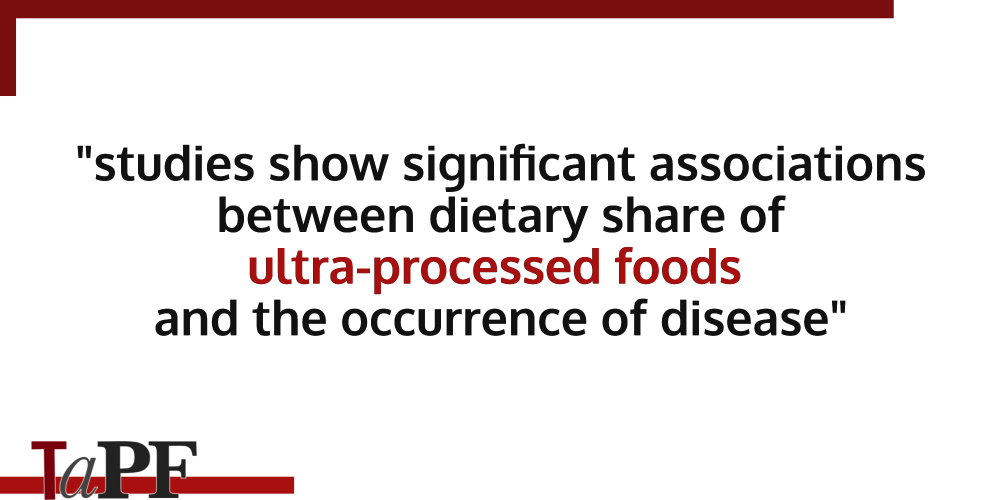With human food, the discussion and study of minimally or ultra-processed foods is common. According to a recent Washington Post article, “in dozens of large studies, scientists have found that ultra-processed foods are linked to higher rates of obesity, heart disease, hypertension, type 2 diabetes, and colon cancer. A recent study of more than 22,000 people found that people who ate a lot of ultra-processed foods had a 19 percent higher likelihood of early death and a 32 percent higher risk of dying from heart disease compared with people who ate few ultra-processed foods.”
But with pet food, the discussion and research of processed and ultra-processed pet food is minimal. A recent study published in the Royal Society Open Science Journal found “Dogs eating dry food had significantly higher GlycA levels than dogs consuming other diet types.” Higher GlycA levels are linked to inflammatory diseases, cancer and heart disease – VERY similar to the research on people consuming a diet high in ultra-processed foods.
Understanding the differences between processed and ultra-processed foods.
The NOVA system is a food classification system “with its identification and definition of ultra-processed foods that has been most applied in scientific literature”. According to the NOVA system, human foods are classified into four groups:

How to distinguish between a processed and ultra-processed pet food.
The Food and Agriculture Organization of the United Nations report “Ultra-processed foods, diet quality, and health using the NOVA classification system” explains the following key differences between processed and ultra-processed food (bold font indicates what can easily be applied to pet food ingredients):
“Industrial breads made only from wheat flour, water, salt and yeast are processed foods, while those whose lists of ingredients also include emulsifiers or colours are ultra-processed.”
With ingredients: “It starts with the fractioning of whole foods into substances including sugars, oils and fats, proteins, starches and fibre. These substances are often obtained from a few high-yield plant foods (such as corn, wheat, soya, cane or beet) and from puréeing or grinding animal carcasses, usually from intensive livestock farming.”
“Some of these substances are then submitted to hydrolysis, or hydrogenation, or other chemical modifications. Subsequent processes involve the assembly of unmodified and modified food substances with little if any whole food using industrial techniques such as extrusion, moulding and pre-frying. Colours, flavours, emulsifiers and other additives are frequently added to make the final product palatable or hyper-palatable.”
If we apply these ultra-processed food markers to pet food, the following ingredients would be classified as ultra-processed (compared to similar ingredients classified as processed):

Heating, pasteurizing, canning, and drying (air drying or freeze drying) are all considered forms of processing; extrusion is considered by NOVA as ultra-processing. Thus, extruded kibble pet foods would be classified as an ultra-processed food for pets.

The Food and Agriculture Organization of the United Nations report states:
“the results from studies show significant associations between dietary share of ultra-processed foods and the occurrence of disease.”
In other words, the more ultra-processed foods consumed – the greater the risk.
To get a sense of how many ultra-processed foods pets can be eating (dietary share), look at the ingredients of this extruded kibble pet food:

Including extrusion, this pet food contains 12 different ultra-processed food markers.
Below are the ingredients of another extruded kibble pet food…

This extruded pet food contains only 2 ultra-processed food markers – a significantly less dietary share of ultra-processed foods.
One more…below are the ingredients of a cooked pet food…

Because this pet food underwent a non-extrusion form of processing, there are zero ultra-processed food markers. The above pet food is processed, but NOT ultra-processed.
The goal for pet owners would be to minimize the number of ultra-processed foods/ingredients in your pets diet.
- If you feed your pet a kibble diet, ask the manufacturer if the diet is extruded. Many biscuit type treats are also extruded.
- Check the ingredient list of your pet’s food and treats – count the number of pre-processed or fractioned ingredients listed above and try to lower that number.
- Add some minimally processed whole foods or a minimally processed topper to your pet’s food (while removing some of the ultra-processed).
Wishing you and your pet the best –
Susan Thixton
Pet Food Safety Advocate
TruthaboutPetFood.com
Association for Truth in Pet Food

Become a member of our pet food consumer Association. Association for Truth in Pet Food is a a stakeholder organization representing the voice of pet food consumers at AAFCO and with FDA. Your membership helps representatives attend meetings and voice consumer concerns with regulatory authorities. Click Here to learn more.
What’s in Your Pet’s Food?
Is your dog or cat eating risk ingredients? Chinese imports? Petsumer Report tells the ‘rest of the story’ on over 5,000 cat foods, dog foods, and pet treats. 30 Day Satisfaction Guarantee. Click Here to preview Petsumer Report. www.PetsumerReport.com
Find Healthy Pet Foods in Your Area Click Here

The 2022 List
Susan’s List of trusted pet foods. Click Here to learn more.



























Emiy annen
October 12, 2022 at 12:34 pm
I have been a dog food advocate for over 20 years. All my fur kids are on homemade diets and doing g great. They are all seniors. 14, 15, 17. No health problems.
Sally
October 12, 2022 at 1:00 pm
Lots of crunchy details for all who think they know!
Diane Timmons
October 13, 2022 at 7:44 am
This is an excellent article. Thanks so much for this valuable information.
Pingback: Feeding the Dog with Cancer – The Healthy Dog Workshop